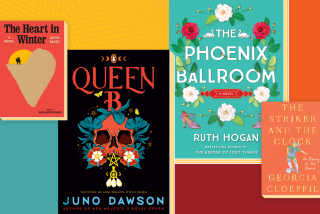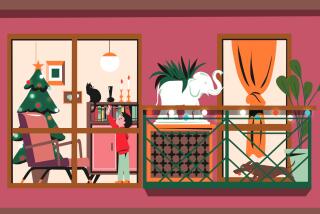A Love for Wild Things Prompts a Beastly Alliance
- Share via
As licensing deals go, it was a match made not in heaven, but in the land of wild rumpuses.
So why did Maurice Sendak, the 72-year-old children’s author and illustrator, make a deal with multimedia maven Todd McFarlane--whose more extreme toys include Death Row Marv, which comes with his own electric chair--to produce action figures based on one of the most beloved children’s books?
Did McFarlane, creator of the violent “Spawn” series, stare into lawyers’ yellow eyes without blinking once to lure “Where the Wild Things Are” to his stable?
No, it was McFarlane’s professed love for the endearing snarling, snorting, squawking critters, Bernard, Moishe, Emil, Aaron, Tzippy and Goat Boy, that sealed the deal, Sendak says.
*
McFarlane’s bad-boy streak--his craftsmanship perennially appears on Christopher Rose’s list of nastiest playthings--didn’t hurt in the least, says Sendak, the author or illustrator of 80 books that have sold more than 7 million copies in at least a dozen languages.
The 1963 book at issue, “Where the Wild Things Are”--in which the protagonist, Max, is banished to his room and conjures up spirited but silly monsters--ranks among the 10 bestselling children’s books of all time.
“When I first heard of him and the Spawn things, I thought, ‘What the hell is this?’ ” Sendak says in a telephone conversation from his home near New Fairfield, Conn. “The stuff he does is totally bizarre. I’m of an ancient generation,” he says.
“After a conversation with Todd on the phone, he was very clear about his literal passion for the wild things. They were very important to him as a little boy. He convinced me he was as crazy about them as I am.”
McFarlane concurs.
“It was always a book I never forgot from my childhood,” McFarlane says. “It was sort of personal. I just said, ‘Get the license. I’m the boss.’ Usually, I ask for input. I thought, nobody is going to get it. I thought it was just an obscure book from my childhood, but then one of my kids came home with the book.”
The toy maker, who is also well-known for his multimillion-dollar purchase of Mark McGwire and Sammy Sosa home-run baseballs, said the wild things fit in with his love of the unconventional, including Dr. Seuss titles.
“I always said I want to meet the people who did this book,” McFarlane says. “Somebody signed off on these guys’ less-than-perfect ideals. And sold them to kids, God bless them.
“The reason I loved the book is it was my early indoctrination into the world of monsters,” McFarlane says. “I have never left it since. I can now blame Maurice for my R-rated antics.”
Sendak fancies himself a bit of an enfant terrible too.
“I was the Todd McFarlane of the 1960s,” he says. “I was severely condemned by librarians and psychologists. [After ‘Where the Wild Things Are’] all of a sudden I got demented. Bruno Bettelheim, the psychologist who worked with autistic children, severely punished me. The wild things were seen as nightmare-provoking. One critic wrote, ‘Do not leave this book in a child’s room!’ It became a joke at the time.”
“It’s a perfect product of the 1960s, and it broke every rule in the book. We never intended it to be a breakthrough, but it turned out to be one. Here was an American child who stood up to his mother. He’s an ill-controlled child. All the other books were, ‘I love my granny.’ ” In 1970, Sendak again squared off against the establishment after librarians around the country edited illustrations that depicted the outline of a little boy’s penis in the book “In the Night Kitchen.”
“I hated the conventional, flat-headed stupidity of objecting to a phallus and them knowing the ramifications of what that meant to little boys--that’s really confusing. What were they to think when what was part of their natural anatomy to be told there was something wrong with it? I was incensed.”
Sendak adds, “I have never written children’s books with the conscious aim of writing for children. Somehow the wiring got screwed up in utero.”
For all that, “Where the Wild Things Are” has stood the test of time. “What was nice about it was that the girls are as crazy and passionate about it as boys,” Sendak says.
“Max was modeled after the self I wish I were. It was my idealization of childhood. That you have the freedom to insult your parents and they do not destroy you. They would get very angry, but you would have the sole knowledge that they still loved you.”
*
As for the beasts, Sendak unflinchingly describes his Eastern European relatives who served as their models.
“I couldn’t tell you that when they were still living,” he says. “I have a vivid memory of childhood of the people who came over from Europe. These were Eastern European Jews who had no place to live, and my father worked endlessly to help them. I just resented their presence. I resented their bad teeth. I resented the hair coming out of their noses. I resented their brutal way of showing affection.
“As the world grew uglier, they grew prettier,” Sendak says.
He’s just as pleased with McFarlane’s three-dimensional realizations, saying that his collaborator delivered on promises that no shortcuts in the manufacturing would detract from the cross-hatched characters with their subdued hues. “He rejected my offer of going easy on the details,” Sendak says. “I am astonished at how beautiful they are.”
The molded rubber figures, about 6 to 8 inches tall, cost $8 to $12 at several major mass-merchandise outlets. “They’re grungy, which is why the cross-hatching works,” says McFarlane, 39. “These things live in the forest, and that’s why they’re not completely manicured.”
“When we were signing at FAO Schwarz [at the Manhattan flagship] there were the people who came out to have my book signed. They were very charming,” Sendak says. “And then there were these mad, savage fans of Todd McFarlane. One hairy one shook my hand and said, ‘Gosh, Mr. McFarlane, you must be so proud of your son.’ And I was.”
More to Read
Sign up for our Book Club newsletter
Get the latest news, events and more from the Los Angeles Times Book Club, and help us get L.A. reading and talking.
You may occasionally receive promotional content from the Los Angeles Times.







